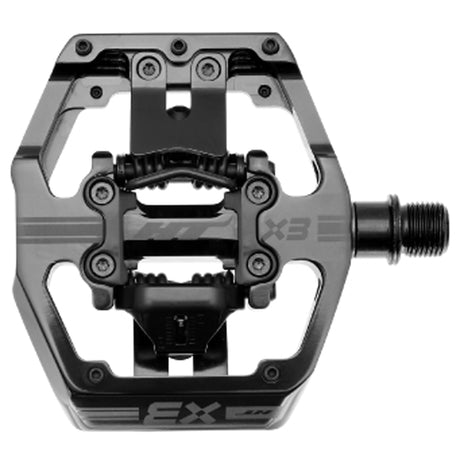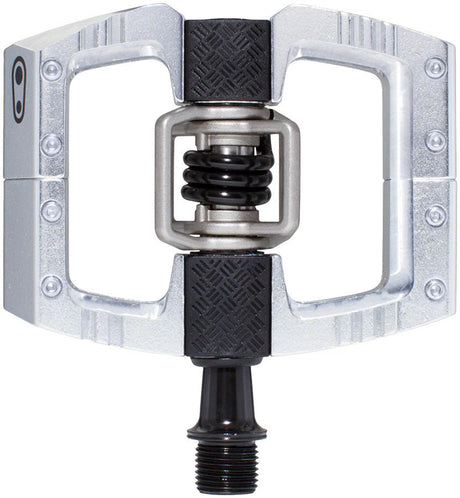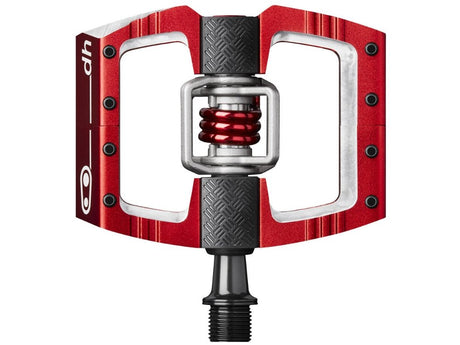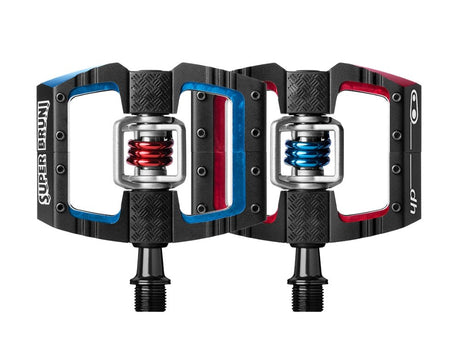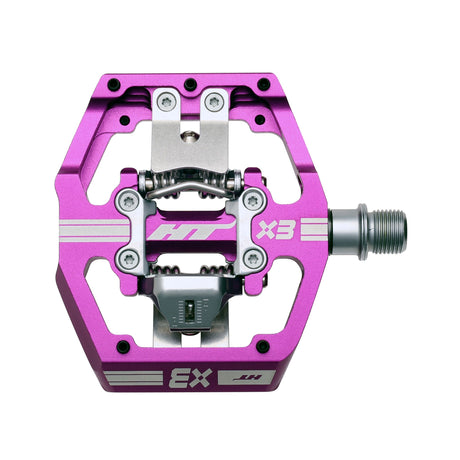Intro
For all the time we spend riding our bikes, we only physically touch them in a few spots while getting our adrenaline fix. Each of these touchpoints are critical to comfort and control on the bike, and personalizing them is the first step to making a bike feel like home. It’s rare that riders prefer the stock grips or saddle, often immediately switching them out for their tried and true favorites. Pedals are so personal that bikes don’t even come with them. Manufacturers know that 99% of riders will switch them out immediately, so there’s no use in wasting money speccing pedals that are destined for the used market.
In pursuit of that comfort and control, I’ve been riding tons of different pedals in the last 6 months. That includes flat pedals and clip pedals, but today we’re just looking at my two favorite clip pedals: the HT X3 and Crankbrothers Mallet DH. If you’ve ever lined up at an Enduro or Downhill race, I’m sure that you’ve seen these two options on several of your competitor’s bikes, and for good reason. While they approach the same goal quite differently, both pedals offer a premium clip pedal experience that has made riders fans for life. Let’s dive into their similarities, differences, and what might make one better for you.
While OneUp’s new Clip Pedals didn’t make it into my top 2, I still have to give them a shoutout for normalizing the Clip Pedal nomenclature. Calling this pedal genre clipless is confusing at best, and I’ll be referring to them as clip pedals from here on out.
Crankbrothers Mallet DH
- Concave machined aluminum body
- Igus bushings, Enduro cartridge bearings and dual lip seals to prevent contamination
- 4-sided clipless entry with customizable float and release angle
- 16 adjustable traction pins per pedal
- 5 year warranty
- $190 MSRP
HT X3
- Large platform extruded and CNC machined aluminum body
- 685zz sealed bearings and Igus bushing
- Adjustable cleat engage/release tension on each side
- 10 adjustable and replaceable pins per pedal
- X1 & X1F cleats, replaceable pins and hardware included
- $200 MSRP
A picture from back in 2022, when I first started using the Crankbrother Mallet DH pedals
Similarities
Both pedals are the most DH oriented options in their respective lineups, with large platforms, strong steel axles, grippy pins, and a stout yet relatively lightweight machined aluminum body. I’ve ridden both of these pedals with a few different shoes, but most often I’ve been in my FiveTen Hellcat Pros with no compatibility issues with either pedals. Internally, both pedals use a combination of IGUS bushings and sealed cartridge bearings, and both can be rebuilt at home by any competent home mechanic. HT and Crankbrothers both offer a catalogue of anodized color options, and both have a variety of cleats with different release properties. While I tested the most affordable versions of both pedals, there are titanium upgrade options for both if you’re looking to save weight at the balls of your feet. You’ll install both with an 8mm allen, as all pedals should, and once you clip in, that’s where the similarities end.
Unfortunately we only had the Crankbrother Mallet E available for photos, but it's similar enough to the Mallet DH to illustrate the differences compared to the HT X3
Differences
For me, there are four categories in which we can compare the riding experience of a clip pedal, and our two contenders are very different in all four. Those four categories are clipping in, clipping out, ride feel while clipped in, and ride feel while unclipped. When you look at the pedals, it’s not surprising they feel so different. Everything including the cleats, clip mechanism, pin locations, and pedal body shape is completely different, and both of these pedals are completely different to anything else on the market. Overall, the HT X3 feels more like a race specific clip pedal, while the Crankbrother Mallet DH is aiming for maximum comfort without sacrificing that precision. But let’s go deeper.
Clipping in
Like I mentioned earlier, the similarities end when the cleat hits the pedal. While every category in this comparison is important, this is the category I value the most. In situations where I dab a foot and need to get my crap together before dropping into the next section of trail as quickly as possible, the ability to quickly get into my pedal is invaluable. Both clip mechanisms are right where I expect them to be on the pedal, allowing me to slap my foot into the pedal at a moment's notice. But it’s not always straightforward. Sometimes I miss on the first try and now I need to scoot my foot around to get into the pedal. For whatever reason, I’m able to get into the HT X3 on my first try more consistently, but the Mallets are more forgiving when you strike on the first attempt and need to scoot your foot around to get them in there.
Egg beaters are at the heart of all Crankbrother clip pedals, and they rotate freely around the spindle to let you clip in from either the front or the back. If your foot lands in line with the clip, you can roll your foot forwards or backwards depending on what side of the clip mechanism you’re on, and it should land home. HT X3’s clip mechanism is fixed, and you have to get in from the correct direction. So if you miss on your first attempt, you need to pick up your foot and start again.
The HT X3 entry is more crisp and pronounced than the Crankbrother Mallet DH. You’ll get a louder click from the HT pedals than the Crankbrothers, and that positive feedback is something I really appreciate. It’s hard to say exactly where those differences come from, but I believe the cleat material is part of the story. All Crankbrother cleats are made of brass, while HT cleats are made of steel. The softer Crankbrother cleat directly translates to a softer and more mushy entrance, while the steel HT cleats feel stiffer and offer more precision.
Not many similarities in the clip design
Unclipping
We’ve all been there. Rolling to a stop, going for the unclip, but the angle isn’t quite right. All you can do is hope no one’s watching as you slowly tip over and try not to break your tailbone. That’s exactly what happened to me on my first ride with the HT X3s, and I couldn’t get my dang feet out on the first try! These pedals have a tension adjustment system, and I started with them right in the middle, but that quickly proved to be too tight for me. Now they’re as loose as they get, and while I don’t have issues with tension, I still struggled to unclip on my front foot. My foot would hit the crank before the cleat was released, so I’ve got my cleats pigeon toed under the shoes to un clip earlier. I can’t imagine anyone would want the tension cranked all the way, but maybe some World Cup Downhill sickos need that in their life. It could be that the clips will break in and I’ll want to add in some tension, but for now they’re staying loose.
The Mallet DH doesn't have any kind of tension adjustment on their pedals, and the tension is similar to my loose HT X3s. Similarly to clipping in, there’s a bit more vagueness to getting out of the Mallets. The softer brass cleats don’t have the same tactile feedback as the steel HT cleats, giving a more muted sound and overall slightly mushier exit. With a very simple clip interface, the Mallets do feel slightly easier to get out of. Those smooth bars catch less on the cleat, while I do feel some catching on the clip interface with the HT X3s. It’s not something that will keep me from getting out, but it’s definitely not quite as smooth of an exit.
That large Crankbrother Pedal body contributes to its flat pedal feel
Clipped in Ride Feel
As important as all the other categories are, this is where we spend the vast majority of our time with these pedals, and it’s also where they’re the most different. Taking a look at the side profile of these two pedals makes it immediately apparent that they’re quite different. HT’s X3 features a very flat pedal body and a raised clip mechanism, which differs quite a bit from the concave pedal body that surrounds the raised clip mechanism on the Crankbrothers Mallet DH. With the raised shape, you can feel the Mallet pedal body while you’re clipped in, giving it a truly unique clip experience. While clipped into the X3, you’re not getting any contact with the pins or pedal body, which means all you’re feeling is the clip to cleat interface.
With that raised shape, the support of the pedal body of the Crankbrothers Mallet DH gives more of a flat pedal feel. Your weight is distributed more evenly throughout the pedal, and feeling the pins gives a totally different feel. Getting the cleat placement in your shoe right is very important, and you’ll need to play with the spacers under the cleat to make sure you’re somewhere between smashed into the pins and hovering above them.
Clip to cleat interface is king, and the two pedals couldn’t go about it more differently. Crankbrothers are known for their float, and float they do. Your cleat floats freely with no resistance from the clip, and you can tune the amount of float via the cleat. Crankbrothers makes cleats with 0° and 6° of float, but the ride feel of those two cleats didn’t match my expectations of the numbers. While it says 0° on the box, there’s more than 0° of action there. Compared to the 6° option, there’s certainly much less, but don’t expect to be fully locked in. Within those few degrees of float, you won’t get any resistance from the cleat, but once you push beyond that zone, there is some resistance before you hit 15° and fully unclip.
On the other hand, the HT X3 is spring loaded and locked in. HT offers a few different cleats, some with 4° and some with 8° of float, but I wouldn’t use the word float to describe these pedals. Both the X1 and X1F cleats are included in the box, and both cleats have some tension on them to keep them centered in the pedal. You can rotate them without unclipping, but there’s a progressive springy sensation that is doing its best to keep them centered. As you push further from center, the resistance builds progressively until you fully unclip. Both the lower float X1 cleats and higher float X1F cleats have the progressive build in resistance, but the X1 starts with less resistance and builds less resistance throughout the whole motion.
I got to borrow some Ti spindle Mallet DH pedals for this race. Save your pennies and get the steel spindle.
Unclipped Ride Feel
Riding bikes would be boring if everything was perfect and always went to plan. Those sketchy moments where you blow your feet off and have to ride a section unclipped are often the most memorable, and the Crankbrother Mallet DH will give you much better odds in those sections than the HT X3. With more pins per side and a taller pedal body, you get far more contact with non clip surfaces, which is exactly how we’ll get as much traction as possible. You’ll get a lot more metal on metal contact with the HT X3, which instills approximately zero confidence. Ultimately, you’re just trying to survive while riding unclipped until you have a moment to get your feet back in, and the Crankbrother Mallet DH pedals make this job much easier.
Livability
Like all mountain bike components, there’s more to the story than just the pure performance. I’ve spent a couple of years on a few different pairs of Crankbrother Pedals, and they’re certainly not without their faults. Choosing brass to manufacture the cleats is an interesting choice, and they wear out much faster than a traditional steel cleat. That soft entry and exit are a product of the brass cleats, and I’d be curious to try a steel Crankbrothers cleat with their pedals.
At the heart of the Crankbrother pedal is the egg beater clip mechanism, which I’ve found does not last forever. I typically get about a season of use out of it before it gets quite loose, and I wish there was a rebuild kit for this part of the pedal. The rest of the pedal is completely user serviceable, but the clip mechanism is unfortunately a wear part.
So far, the HT X3 pedals have been completely problem free, but I haven’t gotten several seasons of use with them like I have the Crankbrothers. Years ago, I used their enduro focused T2 pedals, and found that they developed quite a bit of play after a season, warranting a rebuild to tighten things up again. Unfortunately, I also broke two separate pairs of T2 pedals, leading me to abandon them and jump ship to other clip pedal options. Luckily I haven’t had any issues with the HT X3 so far, but I do have my eye on them.
Mud Performance
As a bonus category, I want to touch on the wet weather performance of both of these pedals. A couple weeks ago, myself and the HT X3s were subjected to some of the nastiest riding conditions I’ve ever experienced. It was a rainy enduro race in northern California, where the clay was thick and did a fantastic job of filling every nook and cranny of the pedals. If I didn’t unclog my cleats and shoes with makeshift tools I picked up off the ground after each stage, I wouldn’t be able to get into the pedals, something that other riders with Crankbrother pedals didn’t experience. This was certainly an outlier in terms of riding conditions these pedals will experience in their lifetime, but the HT X3 pedals do not handle those truly terrible muddy conditions as well as the Crankbrother Mallet DH pedals.
Conclusion
I would be happy to continue using either of these pedals, and I think I’ll continue to flip flop between them going forward. I really appreciate the high quality, snappy engagement of the HT X3, but also love the flat pedal feeling of the Crankbrother Mallet DH. For riders looking for their entrance to clip pedals after years of riding flat pedals, the Crankbrothers Mallet DH is certainly my first recommendation. It offers the most similar feeling to flat pedals while clipped in, and doesn’t have any adjustability to worry about. But for anyone looking for maximum precision between their feet and the pedals, the HT X3s have offered exactly that. Their race focused precision makes them an absolute pleasure to ride, and I recommend them to anyone prioritizing performance from their pedals.

